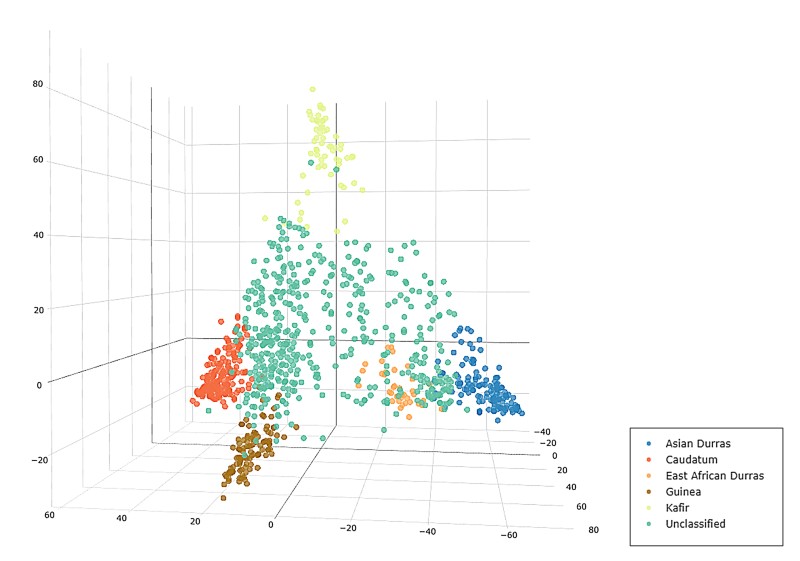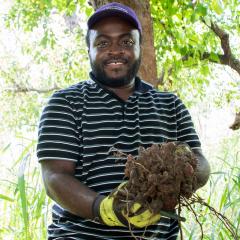Combining genomics, phenomics and modelling, Australian researchers are developing more temperature-tolerant varieties of a staple crop
Half a billion of the world’s poorest people rely on the cereal sorghum to feed themselves and their stock. It’s a crop exquisitely adapted to heat and drought, which explains its popularity in hot, dry environments in Asia and sub-Saharan Africa.
But even sorghum has its limits. In a changing climate, farmers are already finding that extreme heat events are having a negative impact on the productivity of sorghum crops. If temperatures increase at projected rates over coming decades, the consequences could be dire.

At The University of Queensland (UQ), a unique approach weaving together genomic, phenotypic and physiological research is quickly homing in on the genetic architecture of heat tolerance in sorghum. The work aims to provide farmers with varieties of sorghum able to withstand even higher temperatures and secure the productivity of this vital crop into the future.
“The risks for sorghum farmers are becoming more and more severe with climate change,” explains Professor Graeme Hammer of UQ’s Queensland Alliance for Agriculture and Food Innovation (QAAFI), a research institute supported by the Queensland Government. “We need to get ahead of the problem and deliver tolerant material to the agricultural sector.”

As one of the few research-intensive universities worldwide located in a subtropical environment, UQ is a global leader in agriculture and food science research for subtropical and tropical production systems. QAAFI supports this leadership through extensive industry linkages, globally recognized expertise and research infrastructure across a broad range of inter-connected disciplines, to deliver impact across the tropical and subtropical agriculture and food supply chains.
The group’s approach to the heat-tolerance question began with remarkable sorghum populations at the Queensland Government’s Hermitage Research Facility, south west of Brisbane. Here, material representing the diversity of the world’s wild and cultivated sorghum varieties is developed and maintained under the careful eye of Professor David Jordan from UQ.

Hammer, Jordan and their colleagues used this resource to kick off a phenotypic investigation of how different sorghum varieties handle heat. Essentially, large numbers of plants were exposed to high temperatures during a key stage in development, and researchers observed which varieties were able to set fertile seeds.
Subsequent analysis showed that variation in membrane stability and its effect on pollen fertility seemed to be the differentiating factors. The next steps were to understand the genetic architecture that results in this change, and put this into the context of environmental modelling. The outcome is of such value to the agriculture sector that the Australian government has recently awarded the group a prestigious industry-linked project to do just that.
The sorghum heat sensitivity project exemplifies the integrated approach being applied in Queensland, says Hammer. “We refer to this as the GxExM paradigm, which stands for genetics x environment x management. This is an area where crop and climate modelling can connect with the adaptive elements of genetics and agronomy.”

Adrian Hathorn © University of Queensland
This approach has drawn attention from funders such as the Bill & Melinda Gates Foundation, who have been funding Jordan and Hammer since 2012, first to build capacity and productivity for sorghum breeding programs in sub-Saharan Africa and other water-limited environments, and later to investigate problems common to sorghum growers in low-rainfall regions across the globe.
Indeed, Jordan, Hammer and colleagues have a long track record of bringing economic and environmental gains through sorghum breeding programmes through technological innovations. Jordan and colleagues have developed a range of integrated, cross-disciplinary tools to increase the rate of genetic gain made in the program, develop high-yielding elite germplasm and also to support the dissection of complex adaptive traits, including drought and heat adaptation. “We employ an integrated approach using linking technologies, including genomics, high throughput phenotyping, remote sensing and simulation modelling,” explains Professor Jordan, “to build bridges across scales and disciplines and to support information-driven pre-breeding activities.”
The genetic resources developed in Australia have been used to generate productivity increase rates for the crop that are greater than those reported by any other developed nation.
“Connecting our disciplinary strengths allows us to improve plants much more quickly than has been possible in the past,” Hammer says. “This allows the techniques and knowledge that we generate to contribute to food security for many people, including smallholder farmers in Africa.
View the original article on the Nature website.





